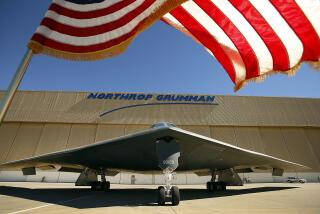DOGFIGHT FOR GRUMMAN : What Would the Deal Cost in Lost Jobs and Facilities?
- Share via
WASHINGTON — If Northrop Corp. buys Grumman Corp., two things are for sure: Some production plants will close, and a good many workers will lose their jobs. The question is, which ones?
In a dozen states, ranging from Northrop’s home base in Southern California to Grumman’s major presence in New York and Florida, the merged company would surely scrutinize its array of facilities for ways to consolidate and cut costs.
Many of these facilities would be permanently shuttered. Thousands of jobs would probably be eliminated.
For example, the combined Northrop and Grumman would have four facilities that can build aircraft, but it might need only one or two. It would have four electronics manufacturing plants that might be reduced to two or three. And the company would have three plants building commercial aircraft structures, while one might be ideal.
Which would survive? The outcome is hard to predict, because the combined company would have so many different products and a wide variety of plants to choose from. What’s more, new government contracts could dramatically alter the equation.
Northrop officials are providing few insights into the outcome, though the company spent about a year examining how Northrop and Grumman might fit together.
“There will be some winners and losers among localities, though the smart thing today for companies seems to be to say, ‘Gee, we haven’t thought about that,’ ” said John Harbison, a Booz Allen & Hamilton aerospace consultant.
But the high probability that Northrop would close facilities indicates a good strategic fit with Grumman. Prudential Securities aerospace analyst Gary Reich said Northrop makes a better match for Grumman than rival Martin Marietta. The two companies are competing to acquire Grumman for a price that will surely exceed $2 billion.
Almost certainly, Northrop would shut down some facilities in Southern California and in Grumman’s home base of Long Island, though it probably would not undertake a wholesale withdrawal from either location, according to analysts, consultants and Northrop insiders.
So much of the intellectual capital of both firms is wrapped up in California and New York that the loss of key employees could swamp any cost savings from such a move, notwithstanding the fact that both states are among the highest-cost areas in the nation to operate.
Further complicating the issue is Northrop’s option to acquire Vought Aircraft Co. of Dallas, a structural parts manufacturer of which it already owns 49%. Vought’s low-cost work force and reputation for quality could influence Northrop to transfer its production of 747 jetliner fuselages to Texas, along with Grumman’s commercial aircraft structure’s business in Stuart, Fla.
Even before the bid for Grumman, Northrop has been shutting facilities in Southern California, including an electronics plant in Anaheim and a drone jet plant in Newbury Park. It also elected to build its Tri-Service Standoff Attack Missile in Georgia.
Yet Northrop is hardly fleeing California. In closing Newbury Park, it transferred production to Hawthorne, where it will also locate some activities from the B-2 plant in Pico Rivera when that closes. Indeed, Hawthorne is representative of many aerospace facilities: It has a well-trained work force, a mixture of buildings and a neighborhood that has deteriorated.
Although Northrop has invested heavily and its manufacturing technology is among the best, portions of the Hawthorne complex date from World War II. In heavy rains, employees have deployed buckets to catch leaking water before it fell on any valuable equipment.
Apart from machinery and bricks, Northrup’s key asset in California is its work force, including the world’s biggest concentration of stealth experts. Similarly, Grumman has 5,200 employees in Bethpage, N.Y.--the world’s largest concentration of naval aircraft designers and naval electronics engineers.
Grumman said earlier this year that it would close its old Calverton, N.Y., facility and move production of the E-2C Hawkeye aircraft to a plant in St. Augustine, Fla. It also operates huge plants with excess capacity in Lake Charles, La.; Stuart, Fla., and Milledgeville, Ga.
If Northrop wins the battle for Grumman, one factor that will favor facilities in California is that Northrop officials know their own plants best.
“There is a tendency to shut down a person’s facilities after an acquisition,” said Jon Kutler, president of Quarterdeck Investment Partners Inc. “It may be a case of the evil you already know.”
Collision Course
Northrop Corp. and Grumman Corp. operate at opposite ends of the country, but the activities at many of their plants are similar. Facilities are sure to be closed and thousands of jobs eliminated if Northrop’s takeover bid succeeds--but where the cuts would come from isn’t clear. A look at some of the firms’ major facilities:
NORTHROP
Headquarters
Los Angeles: 300 employees
Defense electronics, instruments
Rolling Meadows, Ill; 2,800
Norwood, Mass.: 700 Hawthorne*
Aircraft, fuselages, subassemblies
Pico Rivera: 7,700 Palmdale/Edwards AFB; 3,500 El Segundo; 3,500 Hawthorne*
GRUMMAN
Headquarters
Bethpage, N.Y.: 5,200 employees
Defense electronics, systems
Melbourne, Fla.: 1,200
Lake Charles, La.: 520
Space
Titusville, Fla.: 675
Aircraft, subassemblies
Calverton, N.Y.: 1,200
St. Augustine, Fla.: 700
Trucks
Sturgis, Mich.: 760
Montgomery, Pa.: 540
Note: Northrop owns 49% of Dallas-based Vought Aircraft Co. and has an option to buy the remaining 51%. Vought builds aircraft components and subassemblies in Dallas and Grand Prairie, Tex., employing 6,000 workers.
*Overall employment at the Hawthorne plant totals 7,000.
Sources: Northrop Corp., Grumman Corp., Vought Aircraft Co.
More to Read
Inside the business of entertainment
The Wide Shot brings you news, analysis and insights on everything from streaming wars to production — and what it all means for the future.
You may occasionally receive promotional content from the Los Angeles Times.











